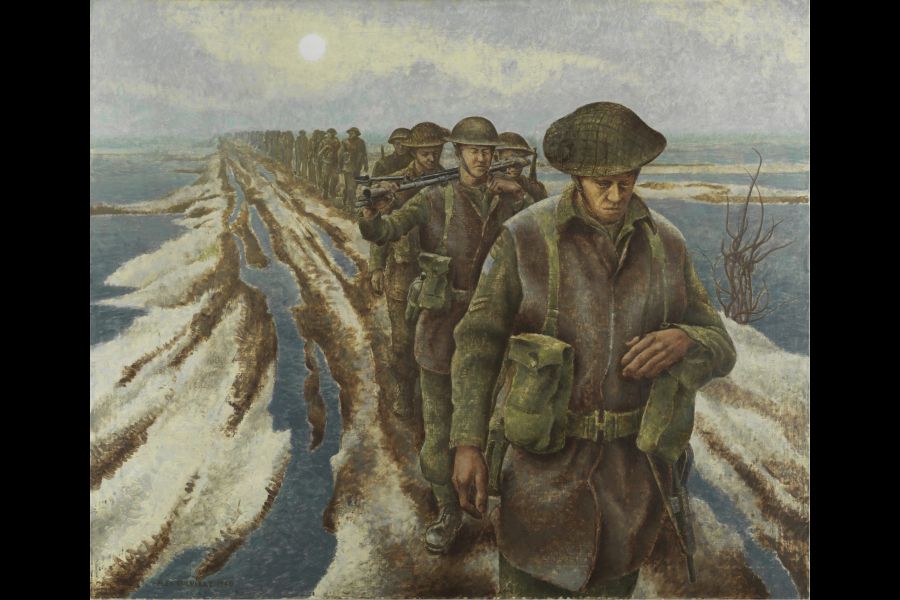On Remembrance Day we shall fix our poppies on our lapels, perhaps attend a wreath-laying at a cenotaph and maybe give thought to fading narratives of family and loved ones who served in wars past.
Those thoughts, those narratives, are often about heroism, patriotism, duty, selflessness. They seldom dwell on the day-to-day slog, the boredom, discomfort, fear and terror that were part of those victories and defeats of armies on the march.
The official Canadian war artist, Alex Colville, gives us both, revealing what it was like to liberate the Netherlands from four years of German occupation during the Second World War.
It’s autumn of 1944. In “Infantry,” we see the Winnipeg Royal Rifles of the 3rd Canadian Infantry Division, a part of the First Canadian Army made up of a large international force of Canadians, British, Polish and Americans.
They have been given a priority directive by the overall commander of the First Canadian Army and the Second British Army, Field Marshall Bernard Montgomery, to capture the vital port city of Antwerp, to clear all access to it, which was the Scheldt estuary, and to the east, near Nijmegen, to overcome the Siegfried Line to prevent the Germans from blowing the bridges across the Rhine, and to advance into Germany itself to defeat the Nazis.
The capture of Antwerp, with its 45 kilometres of docks and its surrounding Scheldt estuary, was essential to landing military supplies for the advance east but they were heavily defended by the Germans. This was to be no easy task.
The men of the 3rd Canadian Infantry Division had landed on Juno Beach on D-Day, June 6, 1944. They had fought fierce battles through Normandy, at Caen and Falaise, and cleared the coast northeast through Belgium to the Netherlands.
The battles through the Netherlands were some of the most difficult of the war because of the unique geography of the flooded lowlands, canals and dykes. In “Infantry,” the soldiers resolutely but wearily plod single file along a water-saturated landscape.
Their eyes are downcast, faces etched with fatigue, damp bodies tense. It’s one foot in front of the other, each man lost in his own thoughts, but with the battle-hardened awareness of the unexpected, of being exposed, at risk, with its accompanying fear.
Colville uses a strong diagonal to bring the soldiers into the foreground. The furrows running parallel to the column reinforce an ordered composition. Colville believed “Infantry” conveyed his perception of war as both heroism and enduring persistence among nature’s elements and constant danger.
He said: “The war had a profound effect on me. But it was all about the action of war. All my instincts as a kid were toward action. And war is action to the nth degree. It’s amazing in a sense how tough people are. I wasn’t sickened or horrified or anything.”
Heavily fought battles were won and the last and most formidable German line of defence, the Rhine, was captured. Second Lt. Alex Colville moved on with the troops into Germany and was exposed to the aftermath of war: the destroyed towns and villages, the scorched earth, dead bodies of soldiers, civilians and animals.
And then, he was assigned to Belsen-Birkenau, the concentration camp with its estimated 35,000 inmates, to record and draw the skeletal dead and dying. Later, he would say that being a war artist, “You are not a camera. There is a certain subjectivity, an interpretive function.”
Colville returned to teach art at Mount Allison University in Sackville, N.B. Fame and international success allowed him to concentrate fully on art and his family in Wolfville, N.S. He died at 93 in 2013.
More than one million men and women served in Canada’s armed forces during the Second World War.
Over 42,000 died, including more than 7,600 who were killed in the eight months it took to liberate the Netherlands. There are 2,300 Canadians buried in the Groesbeek Canadian War Cemetery, close to the Dutch city of Nijmegen. Let us remember their valour and humanity.
Penny-Lynn Cookson is an art historian who taught at the University of Toronto for 10 years. She was also head of extension services at the Art Gallery of Ontario. Watch for her upcoming lectures at the Niagara Pumphouse Arts Centre and at RiverBrink Art Museum in Queenston.










